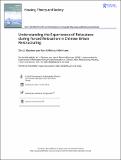Files in this item
Understanding the experiences of relocatees during forced relocation in Chinese urban restructuring
Item metadata
| dc.contributor.author | Li, Xin | |
| dc.contributor.author | van Ham, Maarten | |
| dc.contributor.author | Kleinhaus, Reinout | |
| dc.date.accessioned | 2018-10-31T14:30:05Z | |
| dc.date.available | 2018-10-31T14:30:05Z | |
| dc.date.issued | 2019-07-03 | |
| dc.identifier | 255579558 | |
| dc.identifier | c81ba85d-9174-452c-99fe-10346979aef3 | |
| dc.identifier | 85055742580 | |
| dc.identifier | 000475436400005 | |
| dc.identifier.citation | Li , X , van Ham , M & Kleinhaus , R 2019 , ' Understanding the experiences of relocatees during forced relocation in Chinese urban restructuring ' , Housing, Theory and Society , vol. 36 , no. 3 , pp. 338-358 . https://doi.org/10.1080/14036096.2018.1510432 | en |
| dc.identifier.issn | 1403-6096 | |
| dc.identifier.other | ORCID: /0000-0002-2106-0702/work/64697563 | |
| dc.identifier.uri | https://hdl.handle.net/10023/16362 | |
| dc.description.abstract | Despite the massive forced relocation of residents during urban restructuring in China, there is no systematic overview regarding how residents experience the process and its outcomes. Most studies concerning urban restructuring in China directly equate forced relocation with displacement, which has a negative connotation. This predominantly negative view overlooks the multifaceted effects of forced relocation on relocatees. This paper aims to provide a better understanding of relocatees’ experienced during urban redevelopment in China by establishing a conceptual model in which the time sequence of events and their context are central. It conceptualises forced relocation as a process with various and changing socio-spatial implications over time, and as a specific type of residential mobility that occurs in the context of urban restructuring. As such, the conceptual model divides the process of forced relocation into a pre-demolition stage, a transitional stage and a post-relocation stage and investigates the social, economic, physical, psychological and behavioural dimensions of the experiences of relocatees as affected by the macro and micro context. The conceptual model is used to structure the analysis of the existing literature about residents’ experiences and to subsequently identify the gaps in the literature that should be addressed in future studies of forced relocation in the Chinese context. | |
| dc.format.extent | 21 | |
| dc.format.extent | 1923705 | |
| dc.language.iso | eng | |
| dc.relation.ispartof | Housing, Theory and Society | en |
| dc.subject | Experience of relocatees | en |
| dc.subject | Forced relocation | en |
| dc.subject | Urban restructuring | en |
| dc.subject | Demolition | en |
| dc.subject | Residential mobility | en |
| dc.subject | Displacement | en |
| dc.subject | China | en |
| dc.subject | GF Human ecology. Anthropogeography | en |
| dc.subject | HT Communities. Classes. Races | en |
| dc.subject | T-NDAS | en |
| dc.subject.lcc | GF | en |
| dc.subject.lcc | HT | en |
| dc.title | Understanding the experiences of relocatees during forced relocation in Chinese urban restructuring | en |
| dc.type | Journal article | en |
| dc.contributor.institution | University of St Andrews. School of Geography & Sustainable Development | en |
| dc.identifier.doi | 10.1080/14036096.2018.1510432 | |
| dc.description.status | Peer reviewed | en |
This item appears in the following Collection(s)
Items in the St Andrews Research Repository are protected by copyright, with all rights reserved, unless otherwise indicated.

